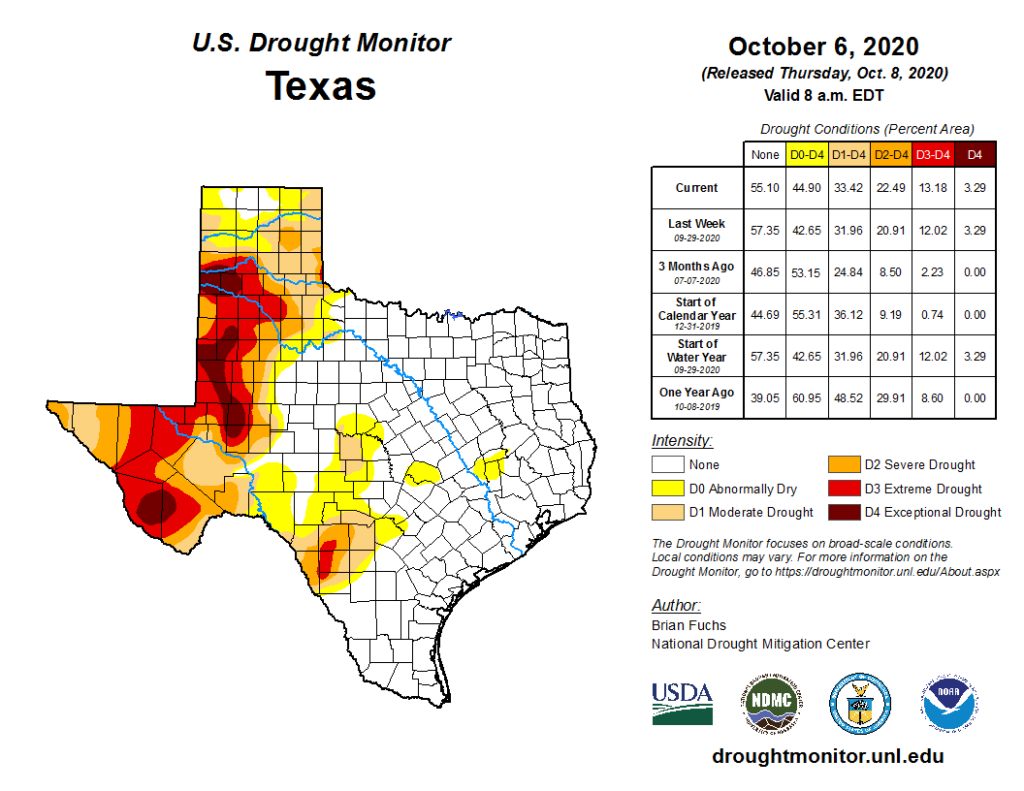Much of West Texas has been experiencing a drought in 2020. Our Mimms Unit is located in Marfa, Texas, in the Trans-Pecos region of the state, which has been hit hard by these drought conditions.

The drought has caused us to come up with a management plan as to not over-stress our livestock or the range. There is much to consider when ranching in drought conditions.
Walt Davis is a fifth generation rancher, author, and is on the ranch committee and board of directors for Dixon Water Foundation. He authored the piece posted below, which addresses drought management, and is particularly relevant for our Mimms Unit ranch at this time:
Drought – by Walt Davis
Droughts are a regular occurrence for most ranching operations since ranches tend to be located in areas of natural grassland and one of the formative factors for grasslands is erratic moisture availability. The frequency and severity of droughts varies according to location and this information is a prime factor in formulating management plans. If drought is recognized as a normal occurrence, then plans can be made to reduce its impact upon the operation and upon the soil-plant-animal complex on which the operation depends. The following is a quick sketch of what occurs (in, more or less, chronological order) during and after drought and to point out management strategies that are useful in alleviating its’ effects.
In the short term:
The rate of forage growth slows.
Stock water quantity and /or quality drops.
Animal production is reduced either by lower animal numbers or by poor performance of the same numbers. The competitive advantage shifts to non-forage and low- quality forage plants as a higher percentage of the quality forage is consumed.
In the mid term:
Both mineral cycling and energy flow through the system began to slow. This puts additional pressure on quality forage species since they tend to require better growing conditions. Weaker individual plants of these species began to die due to overgrazing.
Unless numbers are reduced, animal performance declines as poor nutrition stresses animals and causes them to be more susceptible to parasites and disease. Mortality rates increase in weaker animals.
Surface cover, both living plant and litter declines, which damages the water cycle by reducing water infiltration and by increasing evaporation. Potential for soil erosion by water runoff increases.
Temperatures at and near the soil surface become more extreme due to the loss of insulation effects of turf and litter. Biological activity slows in this critical area further reducing both energy flow and the mineral cycle.
Low humidity at and near the soil surface reduces the establishment of quality forage seedlings and gives competitive advantage to seedlings of non-forage species. This low humidity at the soil surface also reduces the populations of all types of beneficial organisms from spiders and earthworms to beneficial nematodes, bacteria, and fungi. Loss of these organisms sets the stage for later explosive growth of pest organism populations.
Stock water becomes a major problem.
As forage quality and quantity both decline, poisonous plants that would normally not be consumed by livestock become more dangerous. Also poisoning can occur from drought stressed plants that accumulate nitrates due to slow growth or by the formation of prussic acid in certain plants.
If a large area is affected, livestock prices will decline as producers reduce animal numbers.
Long-term effects:
Bare ground increases and long-lived plants such as trees and brush take up most of the available soil moisture. Forage production becomes minimal.
Livestock production is greatly reduced, and wildlife populations suffer.
Soil erosion by wind increases and any rainfall causes erosion.
Biodiversity decreases and populations of beneficial plants and animals are reduced. If the drought is long enough or severe enough, entire species of plants and animals are lost to the local environment.
Effects after drought breaks:
Populations of pest organisms explode. Weeds, grasshoppers, armyworms, fire ants and other species that thrive in a simplified local environment can build large populations very rapidly when moisture returns. These population explosions extend the deleterious effects of the drought by preventing the recovery of populations of beneficial plants and animals.
Soil erosion can be severe if large areas of bare ground have formed. Water infiltration will be below normal until soil cover is reestablished. Floods from excessive runoff may occur even though soil moisture is still below normal.
Succession will have been pushed back by the damage to the mineral cycles, water cycle and energy flow. The extent to which biological succession is repressed is greatly affected by our management practices during the drought. Long-term range deterioration is caused more by our management practices during drought than by the drought.
Planning for drought:
Realize that drought is normal and will occur sooner or later. The frequency with which drought occurs depends upon the location of the area and upon its degree of ecological health. Know the historical frequency of drought for your area and plan accordingly. The effects of dry weather are in direct proportion to the health of the range. Degraded range suffers sooner and more severely than does healthy range. Know the condition of your country and do all that is feasible to improve your range while conditions are good.
If you operate in a drought prone area, the first order of business should be to make realistic financial plans to cope with the drought that is surely coming. If your operation is such that you are not building a surplus reserve, you would be wise to change the operation. By the same token, you should prepare mentally for the coming drought. The stress and helpless feeling that come from not being in control of your operation, can literally be life threatening. If you know a drought is coming, it can be planned for and not become a mental or financial disaster.
Plan the mix of enterprises to the likely frequency and severity of drought. Set up a mix of livestock that allows stocking rate to vary with a minimum of disturbance to the overall operation of the ranch. This mix might range from 10 % stockers and 90% registered cows in an area little subject to drought; to stocker goats purchased only in the years that it rains on country subject to frequent and severe drought. Get ready to lighten the load on your range at short notice and with minimal financial damage. Plan to reduce stock numbers before it becomes absolutely necessary. Once growth stops, the sooner numbers are reduced the more animals can be saved.
Know the realistic carrying capacity of your country and the results of over stocking.
Subdivide your country so that time control management becomes feasible. This subdivision can normally be more than paid for with increased production and decreased costs. Design, implement and continually update a grazing plan for each unit on the ranch. Build a time reserve for drought into the plan. When drought occurs, combine herds wherever possible to increase the number of paddocks available to each herd. This makes longer recovery periods possible without increasing the length of the graze periods. As growth slows during a drought, recovery periods must be lengthened if damage to the vegetation is to be minimized. Keeping graze periods short is the key to good animal performance.
Develop water in excess of what you expect to need. One or two weak water points can disrupt the entire grazing plan, bring about unnecessary damage to range through overuse, and cause poor animal performance.
Understand that the long-lasting damage of a drought comes from a loss of biodiversity and a regression of biological succession. Began building biological capital, which is high biodiversity plus the long- term effects of having high biodiversity. This is the factor that gives stability as well as productivity to range. Manage to push biological succession forward and biodiversity will increase. Improving the mineral cycles, the water cycle and the amount of energy flow through the system is the key to stability and productivity.
Learn the normal weather patterns of your area and be alert for early signs of drought. Know in what time period the forage you depend upon is grown. If moisture is low or ineffective going into the period of peak growth, some degree of drought is almost certain.
Understand the relationships between animals, plants, and soil in a rangeland situation. In times of drought, animals will suffer permanent damage before the vegetation is permanently damaged. Most permanent drought damage to the vegetation and the soil of a range comes about because animals are held on an area long after the ability of the land to feed them is gone. Droughts have come and gone for eons without destroying the range. Before man brought increased water supplies and feed, when drought became serious the animals either moved or died. By feeding animals on drought-stricken range, we compound the damage many times over by destroying soil cover and thus the soil. Animals recover from stress faster than range forage and range forage recovers much faster than does soil. It is very possible to save the herd and lose the ranch.
Know the difference between feeding for supplementation and feeding for substitution. Supplementing low quality forage with protein or minerals can be a valuable tool. Substitution feeding of animals seldom makes economic or ecological sense. If the decision is made to use substitution feeding, put the animals into drylot to prevent damage to the range. Livestock can be replaced much more quickly then damage to the range can be repaired.
Management after the drought:
Expect a plague of weeds along with grasshoppers, armyworms or whatever pest organisms are common to your area. These population explosions come about because of the reduced amount of life in the area due to the drought. Be careful that your response to the situation does not increase the problem. Weeds are natures’ way to respond quickly to bare ground. If there is nothing growing but weeds and you kill the weeds, you still have no forage, but you do have bare ground. Pest organism explosions occur because of a lack of biodiversity. Be careful that your response doesn’t further reduce biodiversity and make the problem worse.
Do not be in a hurry to re-establish the old number of herds. Keep your stock density high after the drought breaks unless there are compelling reasons not to do so. High stock density is a powerful tool for improving mineral cycle, water cycle and energy flow and thus moving biological succession forward. It is also the most effective tool to deal with the plagues of pest organisms as it addresses the root cause of these plagues, which is low biological activity.
If you do not have a monitoring program in place, use the end of the drought as a starting point and began monitoring the health of your range. With good management, improvement will be rapid after good conditions return and this will offer an excellent opportunity to learn how the range heals itself given the chance. Set up permanent photo points and began a formal monitoring process addressing the whole soil-plant-animal complex.
Our management determines the health of our grazing lands. If our practices promote healthy ecological processes: good water cycles, rapid mineral cycling and strong energy flow; biological succession will advance, and our ranges will become both more productive and more stable. Our management during drought is particularly critical since the ecological processes are under stress so that the effects of management mistakes are magnified. Natural grasslands are extremely stable due to their complexity and to the health (read high organic content) of their soils. These grasslands evolved with drought over eons of time. When nature was managing the show, if drought became severe, the grazing animals either left or died. Charles Goodnight writes of riding across the Llano Estacado in the early 1870’s and not being out of sight of drought killed buffalo for two days. The drought ended and the prairie came back just as it had hundreds of times before. Drought does not destroy grassland, our management during drought destroys grassland. If we are going to operate in drought prone areas, we would be wise to study natures’ means of range management. Some of nature’s most valuable tools are; keeping stock density high, matching the demands for forage to the production of forage especially during drought, matching recovery time to growing conditions and never leaving animals on the range when it has lost its’ ability to produce the feed they need. Do these things in an economically feasible way and your operation has a head start in the race for success.
Walt Davis © 1998

